Birds in the News #34
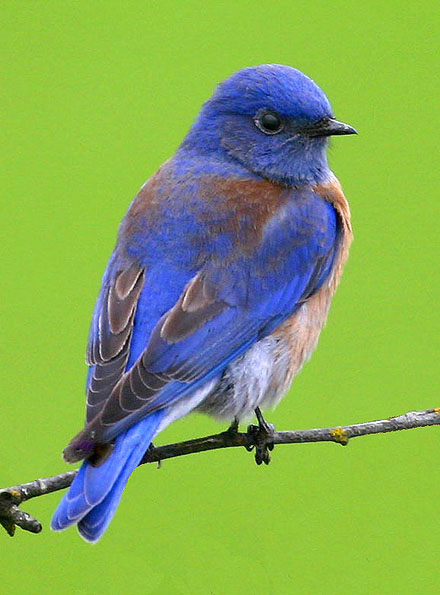
Male Western Bluebird, Sialia mexicana.
Photo by Nan Moore.
Birds in Science
What is the connection between wine and bluebirds? According to a recently published study, Western Bluebirds, Sialia mexicana (pictured at top), are increasingly falling on hard times along the Central Coast in California, in part, at least, because these are good times for grape growers. If bluebird families don't have enough mistletoe berries to eat during the winter, their sons are apt to up and leave, the study showed. But mistletoe grows in oak trees, and oak trees are disappearing all too rapidly as land is cleared for agriculture -- especially vineyards. The intersting study, which is presented in this linked news story, was co-written by Andrew McGowan of the United Kingdom and published online in The Proceedings of the Royal Society B last month and will come out in print later this year. The study was conducted at the Hastings Reserve in upper Carmel Valley while Dickinson was an associate research zoologist there. She is now an associate professor at Cornell University and the director of citizen science at the Cornell Laboratory of Ornithology.
People Hurting Birds
Bizarre and wildly fluctuating weather patterns have confused - and could yet kill - plants and animals across the country. Botanists, twitchers and wildlife-watchers in Scotland say last week's record-breaking heatwave fooled numerous species into believing winter had already passed. They now fear animals and plants will perish in their tens of thousands if, as predicted by some experts, the UK suffers its coldest winter for years with temperatures as low as minus 27°C. GrrlScientist note: I have never had the priviledge of visiting Scotland, but this scenario sounds rather melodramatic.
The avian influenza panic has caused uninformed or stupid people to release their pet exotic birds outdoors rather than take them to the vet to be tested for the virus. GrrlScientist comment: Even though this story reports what is currently happening in Rochdale, UK, this is happening elsewhere and will also happen in the USA after influenza arrives here. My hope is that the public will spend even as much as three minutes talking to their vet or reading accurate reality-based information on the internet, because pet birds cannot possibly be a source of the influenza virus. The only way a pet bird can infect humans with avian influenza is if the birds were housed outdoors with domestic poultry that died from avian influenza, or if they were in close physical contact with wild migratory birds, especially waterfowl, that were shedding this virus. Don't forget that bird flu is not easily passed from an infected bird to a human, either. It requires very close contact, or that the person drinks the bird's blood, raw. How many pet owners are going to do that?
Those of you who believe that abandoned and unwanted or neglected pet cats that roam freely in a city or elsewhere are not a menace should think again. This excellent story describes the many problems created by free-roaming cats. Pet owner negligence is the Number one contributor to the feral cat population, experts say. "People need to know how to take care of their pets," said Marc Hammond, a member of the Animal Welfare Alliance of Southern Arizona, and co-owner of Animal Experts Wildlife Rescue and Trapping Services. "If you own a cat in the US, it's not a right; it's a privilege." Nationwide, an estimated 70 million feral cats are roaming, more or less the same number as house cats.
People Helping Birds
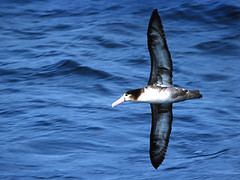 With almost all of the world's remaining Short-tailed Albatrosses, Phoebastria albatrus (pictured), breeding on a steep slope of a Japanese volcanic island that is subject to eruptions, mudslides and erosion, an international team of scientists has a proposal to help the endangered birds by luring them to a safer island. The relocation idea, part of a draft recovery plan released on Thursday by the US Fish and Wildlife Service, involves the use of decoys and recorded bird calls to make some other site seem as enticing as Torishima Island. The approximately 2,000 short-tailed albatrosses left in the world spend their winters on the remote Japanese island but spend their summers spread out over Alaska's southern coastline. "You're not going to get adults to change. If there's a bunch of lava coming down and they're incubating an egg, they're just going to sit right there and let the lava roll right over them," said Greg Balogh, a Fish and Wildlife Service biologist who is coordinating the recovery plan. Instead, the plan focuses on chicks, which might form attachments to new places if moved at the correct time, he said. A new island has not yet been chosen for the birds.
With almost all of the world's remaining Short-tailed Albatrosses, Phoebastria albatrus (pictured), breeding on a steep slope of a Japanese volcanic island that is subject to eruptions, mudslides and erosion, an international team of scientists has a proposal to help the endangered birds by luring them to a safer island. The relocation idea, part of a draft recovery plan released on Thursday by the US Fish and Wildlife Service, involves the use of decoys and recorded bird calls to make some other site seem as enticing as Torishima Island. The approximately 2,000 short-tailed albatrosses left in the world spend their winters on the remote Japanese island but spend their summers spread out over Alaska's southern coastline. "You're not going to get adults to change. If there's a bunch of lava coming down and they're incubating an egg, they're just going to sit right there and let the lava roll right over them," said Greg Balogh, a Fish and Wildlife Service biologist who is coordinating the recovery plan. Instead, the plan focuses on chicks, which might form attachments to new places if moved at the correct time, he said. A new island has not yet been chosen for the birds.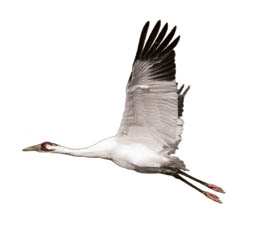 A guide is available for distinguishing endangered Whooping Cranes, Grus americana (pictured), from other birds that appear similar in flight, such as White Pelicans, Pelecanus erythrorhynchos, and Sandhill Cranes, Grus canadensis, is available online. Includes a link to the streaming news report comparing these cranes to other birds.
A guide is available for distinguishing endangered Whooping Cranes, Grus americana (pictured), from other birds that appear similar in flight, such as White Pelicans, Pelecanus erythrorhynchos, and Sandhill Cranes, Grus canadensis, is available online. Includes a link to the streaming news report comparing these cranes to other birds. Bird Flu News
The man who runs the quarantine center in the UK where two Amazon parrots died from bird flu has a history of evading quarantine procedures. The Government was recently facing questions over why Brett Hammond, who runs the Pegasus Birds Centre in Essex, was given a licence to quarantine birds when he has a self-confessed history of ignoring quarantine rules. Customs officers claim that Hammond made up to £4m through his alleged bird-smuggling operation. At his appeal hearing in June 1997, at which his 18-month jail sentence was reduced to a year, it was disclosed that the reason for his tax evasion scheme was to avoid having to put birds through a month-long quarantine, a process that cost him time and money. As if that is not bad enough, it has also emerged that Howard Savage, who helps to run the quarantine center, also works at a local hospital, fuelling fears of a spread of the influenza strain. Hammond kept the (now dead) parrot in a cage in "quarantine" in his back yard. GrrlScientist comment: this story is so astonishing that it almost deserves its own category; Unbelievably Stupid People and the Greed-Driven Things They do to Innocent Birds.
For your reference, here is a basic primer on How Bird Flu is Transmitted. Please add it to your list of bookmarks.
The Australian Medical Association (AMA) also issued a recent warning against overreacting to avian influenza. "[We must] reassure the public that they are in no immediate danger so that they don't get too concerned about rushing off, getting immunisations that don't exist, and rushing off getting tablets and sprays against influenza that may not work," said Dr Mukesh Haikerwal of the AMA.
Governmental overreaction to the bird flu can be conveniently used as a political and economic weapon, as we currently see in several South American countries. GrrlScientist wonders; Hrm, what next?
Where is the next logical place for bird flu to pop up? Researchers think the next stop for the bird flu, which threatens a global pandemic, will be Africa, where it could have a major impact. The H5N1 virus is expected to be carried by migratory birds into the Middle East and east Africa within weeks, according to the United Nations' Food and Agriculture Organisation (FAO). In a special report, the top-tier research journal Nature said the health and economic consequences could be worse than in south-east Asia where the virus is already widespread. The pattern of the virus's spread to date points strongly to wildfowl travelling southwest from northern Russia to the African continent.
The US Agriculture Department said on Wednesday it would step up testing of migratory fowl for bird flu as part of federal precautions against the deadly disease. The US government said it is planning more extensive testing in 2006 in the flyways where wild birds, believed to be the primary carrier of the disease, enter the United States. Officials did not say how many birds would be tested or where, but wild birds are expected to carry avian influenza into the USA by way of Alaska along the western flyway. The United States is the world's largest producer and exporter of poultry meat, with chicken, turkey and duck production valued at about $23 billion annually, and exporting approximately 5.4 billion pounds of chicken meat in 2005 alone.
But the US Agriculture Department and other official agencies throughout the world would be well-advised to remember that there’s no record of avian flu in wild birds or cases of humans being infected with the disease by wild or migratory birds. Bird Life International, British Trust for Ornithology and the Royal Society for the Protection of Birds, in a statement, said that while there are numerous strains — at least 144 — of avian influenza, most of these viruses within wild bird populations are benign. “Highly pathogenic-avian influenza viruses (including H5N1) can cause great mortality in domestic poultry flocks, but are very rare in wild birds,” the statement said. “H5N1 is highly pathogenic but was never recorded in wild birds before the recent outbreaks in Southeast Asia, Russia and countries around the Black Sea. It is likely that it originated in domestic poultry through mutation of low pathogenic sub-types and was subsequently passed from poultry to wild birds.” The statement noted that there is a possibility that migrating water birds may be involved in the spread of the virus.
The parrot, named Koki, who belonged to the former Yugoslav leader Josip Broz Tito has been placed in quarantine as a precautionary measure following the bird flu cases reported in Croatia. The Croatian media reported that Koki has been quarantined along with other birds in the northern Adriatic archipelago Brijuni, a former summer residence of Tito, who passed away back in 1980. Koki, who is a talking parrot, is a tourism attraction for all guests at Brijuni. Earlier in the week the strain of the bird flu virus lethal to humans was found in Croatia. GrrlScientist comment: this sounds like a bit of an overreaction unless this parrot was exposed to birds that are known to have died from avian influenza. On the other hand, at least the bird was not "culled" -- a definite overreaction!
Streaming Birds
This week, BirdNote celebrates Hallowe'en with Spooky Shearwaters; Freeway Hawks; Beaks and Bills; The Douglas Squirrel, Tamiasciurus douglasii; and Birds in the Winter Garden. BirdNote shows are two-minute vignettes that incorporate the rich sounds of birds provided by Cornell University and by other sound recordists, with photographs and written stories that illustrate the interesting -- and in some cases, truly amazing -- abilities of birds. Some of the shows are Pacific Northwest-oriented, but many are of general interest. BirdNote can be heard live, Monday through Friday, 8:58-9:00AM on the radio throughout Western Washington and Southwest British Columbia and is also available as RSS/Podcast feeds. All episodes are available in the BirdNote archives, both in written transcript and mp3 formats, along with photographs. Incidentally, BirdNote can be heard in North Central Washington beginning the week of November 7 [mp3/podcast].
Miscellaneous Birds
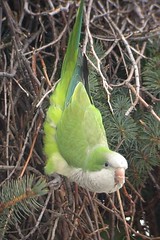 Who says there aren't feral parrots in NYC?? If you look around, you'll find that one of the light poles next to Brooklyn College's athletic field is crowned with a large nest made of sticks. This shelter is a sturdy home to an extended family of small green parrots known as Myiopsitta monachus (pictured) - Monk (Quaker) Parakeets to you - who have thrived in Brooklyn for the better part of 30 years, well outside their native habitat in South America. The small birds have fist-size bodies and long tails, they are covered in mossy green feathers with notes of blue peeking out beneath. When about a dozen converged on some human-provided seed, a few of them began to squawk angrily at one another. "They're having an argument there," said birder, Steve Baldwin, who works in marketing for a small publishing house. "But this is Brooklyn, so that's to be expected." Mr. Baldwin has been a devoted fan of these birds; he even started a free blog about these birds in March, BrooklynParrots.com.
Who says there aren't feral parrots in NYC?? If you look around, you'll find that one of the light poles next to Brooklyn College's athletic field is crowned with a large nest made of sticks. This shelter is a sturdy home to an extended family of small green parrots known as Myiopsitta monachus (pictured) - Monk (Quaker) Parakeets to you - who have thrived in Brooklyn for the better part of 30 years, well outside their native habitat in South America. The small birds have fist-size bodies and long tails, they are covered in mossy green feathers with notes of blue peeking out beneath. When about a dozen converged on some human-provided seed, a few of them began to squawk angrily at one another. "They're having an argument there," said birder, Steve Baldwin, who works in marketing for a small publishing house. "But this is Brooklyn, so that's to be expected." Mr. Baldwin has been a devoted fan of these birds; he even started a free blog about these birds in March, BrooklynParrots.com. 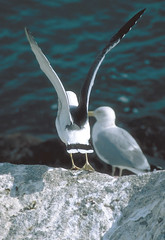 A Black-tailed Gull, Larus crassirostris (pictured), normally found around the seas of Japan or along China's northeast coast, has turned up on the shores of Lake Champlain, Vermont. "This bird has never been seen in Vermont, and it's extraordinarily rare in the US," naturalist Bryan Pfeiffer said. Pfeiffer speculated the bird was thrown off course by a storm, migrated in the wrong direction or could have gotten a ride on a ship.
A Black-tailed Gull, Larus crassirostris (pictured), normally found around the seas of Japan or along China's northeast coast, has turned up on the shores of Lake Champlain, Vermont. "This bird has never been seen in Vermont, and it's extraordinarily rare in the US," naturalist Bryan Pfeiffer said. Pfeiffer speculated the bird was thrown off course by a storm, migrated in the wrong direction or could have gotten a ride on a ship. Speaking of lost birds that are giving birders a cheap thrill .. Hurricane Wilma has given bird watchers a treat after dozens of rare feathered visitors appeared on the island as the monster storm passed to our west.
The extraordinary influx of birds included Frigate birds, Sandwich terns, Sterna sandvicensis, Royal Terns, Sterna maxima, and Yellow-billed Cuckoos, Coccyzus americanus. Andrew Dobson, president of the Bermuda Audubon Society, said Wilma had brought unprecedented numbers of seabirds. He noted that seabirds have a good chance of survival when being blown off course by severe weather, but thousands of landbirds will not have been so fortunate. "Many thousands of migrant birds will have perished at sea, judging by the large number of landbirds that have arrived," he said. National Public Radio's Weekend Edition broadcast a story recently about these hurricane-misplaced birds that you will enjoy listening to.
This is a love story that might warm your feathery heart; Princess Sayako (also known by her nickname, Princess Nori), the daughter of the Emperor of Japan, will marry. Her match is Yoshiki Kuroda, a 39-year-old urban planner who still lives with his mother. Princess Nori, who is an avid bird watcher, part-time researcher at the Yamashina Institute for Ornithology and co-author of a book about her hero, John Gould (the British ornithologist), were members of the same nature-lovers club when they met. Unfortunately, single women in Japan, referred to as loser dogs, will be deprived of their most famous icon when Princess Nori marries.
Thanks to my bird pals; Ian, Cheri, Leslie, Ellen and Ron for some of the links you are enjoying here.
tags: Birds in the News, ornithology, birds, avian, newsletter
© 2004, 2005, 2006 by GrrlScientist











2 Peer Reviews:
OK, now I am having a schizophrenic moment. I have put out houses for bluebirds and I have actually chased away a mockingbird that was harassing a new bluebird stargin a nest and yet I am a lover of wine!
Whoa there!
Botanists, twitchers and wildlife-watchers in Scotland say last week's record-breaking heatwave fooled numerous species into believing winter had already passed. They now fear animals and plants will perish in their tens of thousands if, as predicted by some experts, the UK suffers its coldest winter for years with temperatures as low as minus 27°C.
The UK could suffer its coldest winter in years without it being very frosty at all. We've had a run of very warm winters, and the prediction this year is for more "average" temperatures, that's all. Of course, that doesn't make for a very interesting newspaper story...
Minus 27C is the record in Scotland, established in 1995. Ooh, it was cold then. But for now, I can look out the window and still see (some) green leaves. And there's a huge bunch of starlings chattering somewhere nearby...
Post a Comment
<< Home